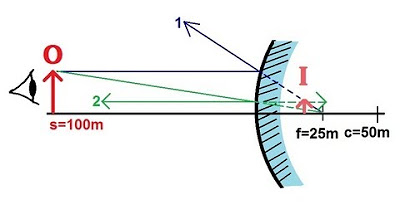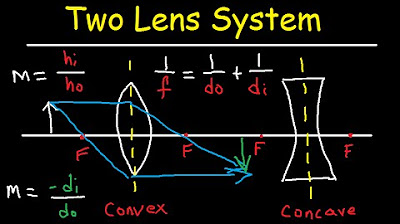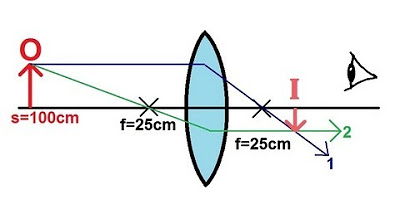Physics 59 Optical Instruments (1 of 20) Magnifying Glass
TLDRThis lecture delves into the workings of a magnifying glass, the simplest optical instrument. It explains how placing an object at the focal length with relaxed vision creates a virtual image with increased angular size, thus magnifying the object. The script clarifies the concept of magnification as the ratio of the new to the original angular size. It also explores the mathematical relationship between the object's distance, the lens's focal length, and the resulting magnification, both with relaxed and strained vision, providing formulas and examples to calculate magnification in different scenarios.
Takeaways
- 🔍 The simplest optical instrument is the magnifying glass, which works by altering the angular size of an object to make it appear larger.
- 👀 Angular size (θ) is the ratio of the object's height (H) to its distance from the observer, determining how large the object appears.
- 🌟 When using a magnifying glass, the object is placed at the focal length (F) from the lens, creating a virtual image that appears larger due to the increased angular size.
- 📐 The magnification of a magnifying glass is the ratio of the new angular size (θ') to the original angular size (θ).
- 📚 The tangent of an angle in a right triangle can be used to calculate the magnification, where the tangent of θ is H/distance and θ' is H/F.
- ≈ For small angles, the tangent of the angle is approximately equal to the angle itself, simplifying the calculation of magnification.
- ⚖️ Magnification is calculated as 25/F when the object is placed at the focal length, where 25 cm is the distance from the observer to the image.
- 🔢 If the focal length of the lens is 10 cm, the magnification is 2.5, indicating the object appears 2.5 times larger than its actual size.
- 👁️ 'Relaxed vision' means placing the object at or near the focal point, resulting in an image formed far away that can be viewed comfortably.
- 👓 'Strain vision' is used when the object is placed closer to the lens than the focal length, resulting in a larger image formed at a closer distance.
- 📏 To find the exact object distance for a specific image distance, solve the lens equation for s, which relates object distance (s), image distance (s'), and focal length (F).
- 📚 The general formula for magnification when the image is formed at a distance of 25 cm (with strain vision) is 25/F + 1, providing a larger magnification than with relaxed vision.
Q & A
What is the simplest optical instrument discussed in the script?
-The simplest optical instrument discussed in the script is the magnifying glass.
What is meant by the angular size of an object?
-The angular size of an object is the angle it subtends at the eye, which is the ratio of the object's height to the distance from the object to the observer.
How does placing an object closer to the observer with a magnifying glass change its angular size?
-When an object is placed closer to the observer with a magnifying glass, the angular size appears larger because the ratio of the object's height to the distance is increased.
What is the relationship between the magnification of a magnifying glass and the focal length of the lens?
-The magnification of a magnifying glass is equal to 25 divided by the focal length of the lens when the object is placed at the focal point with relaxed vision.
What is relaxed vision in the context of using a magnifying glass?
-Relaxed vision means looking at the object placed at or just very near the focal point of the lens, allowing the observer to see a virtual image behind the object without straining the eyes.
How does the position of the object relative to the lens affect the magnification?
-If the object is placed closer to the lens than the focal length, the magnification increases because the image is formed closer to the observer, allowing for strain vision and a larger apparent size.
What is the formula for calculating the magnification of a magnifying glass with relaxed vision?
-The formula for calculating the magnification with relaxed vision is magnification = 25 / F, where F is the focal length of the lens.
What is meant by strain vision when using a magnifying glass?
-Strain vision refers to looking at an image that is formed closer to the observer than the normal viewing distance, which can be achieved by moving the object closer to the lens than the focal point.
How can you calculate the new magnification when using strain vision with a magnifying glass?
-The new magnification when using strain vision can be calculated using the formula magnification = 25 / F + 1, where F is the focal length of the lens.
What is the significance of the tangent of theta and theta prime in the script?
-The tangent of theta and theta prime are used to approximate the small angles in the geometric representation of the magnifying glass setup, allowing for the simplification of the magnification calculation.
How does the script explain the relationship between the object distance and the image distance in a magnifying glass setup?
-The script explains that when the object is placed very close to the focal point, the image distance becomes very large, allowing for relaxed vision. Conversely, moving the object closer to the lens than the focal length results in a smaller image distance, requiring strain vision.
Outlines
🔍 Understanding Magnifying Glass Basics
This paragraph introduces the concept of using a magnifying glass to enlarge the appearance of an object. It explains the principle of angular size (theta) as the ratio of object height to the distance from the observer. The magnifying glass is placed at the focal length from the observer, creating a virtual image that increases the angular size (theta prime), thus magnifying the object. The magnification is determined by the ratio of theta prime to theta. The tangent function is used to relate the object's height to the distance, and for small angles, the tangent of theta is approximated as theta itself. The formula for magnification is derived as 25 divided by the focal length of the lens, exemplified with a lens having a 10-centimeter focal length, resulting in a 2.5x magnification.
👀 Adjusting Magnification with Object Placement
The second paragraph delves into how the placement of the object affects the magnification power of a magnifying glass. It discusses two scenarios: looking through the lens with relaxed vision, where the object is placed at or near the focal point, and looking with strain vision, where the object is moved closer to the lens to form a larger image at a set distance (25 centimeters in this case). The mathematical relationship between object distance, image distance, and focal length is explored to calculate the new object distance required for the desired magnification. The general formula for magnification is provided, which includes an additional 'plus one' factor when using strain vision. An example calculation is given for a lens with a 10-centimeter focal length, showing that moving the object to 7.14 centimeters from the lens results in a 3.54x magnification.
Mindmap
Keywords
💡Optical instruments
💡Magnifying glass
💡Angular size
💡Focal length
💡Virtual image
💡Magnification
💡Tangent
💡Relaxed vision
💡Strain vision
💡Lens equation
💡Object distance
Highlights
Introduction to the lecture on optical instruments, starting with the magnifying glass.
Explanation of how a magnifying glass works by altering the angular size of an object.
The concept of angular size as the ratio of object height to the distance from the observer.
The effect of placing an object at the focal length of a magnifying glass to create a virtual image.
Relaxed vision through a magnifying glass and its impact on the perceived size of the image.
Calculation of magnification as the ratio of the new angular size to the original.
Use of tangent function to relate the object height and distances in the magnification process.
Approximation of tangent for small angles to simplify the magnification calculation.
Derivation of the magnification formula as 25 divided by the focal length of the lens.
Example calculation for a magnifying glass with a 10-centimeter focal length, resulting in 2.5x magnification.
Difference between relaxed vision and strain vision when using a magnifying glass.
How to adjust the object's distance from the lens to change the image distance and magnification.
Equation for the object distance to achieve a specific image distance with a magnifying glass.
General formula for magnification when using strain vision and its derivation.
Final magnification formula incorporating the focal length and desired image distance.
Practical application of the magnification formula for different viewing conditions.
Summary of the key points for determining magnification with a magnifying glass.
Transcripts
Browse More Related Video

Physics 59 Optical Instruments (3 of 20) The Microscope

Physics 54 Optics: Mirrors (4 of 6) Convex Mirror

Physics - Optics: Lenses (2 of 2) Diverging Lens

Multiple Two Lens System with Diverging and Converging Lens

Physics - Optics: Lenses (3 of 4) Converging Lens

Physics - Optics: Lenses (1 of 4) Converging Lens
5.0 / 5 (0 votes)
Thanks for rating: